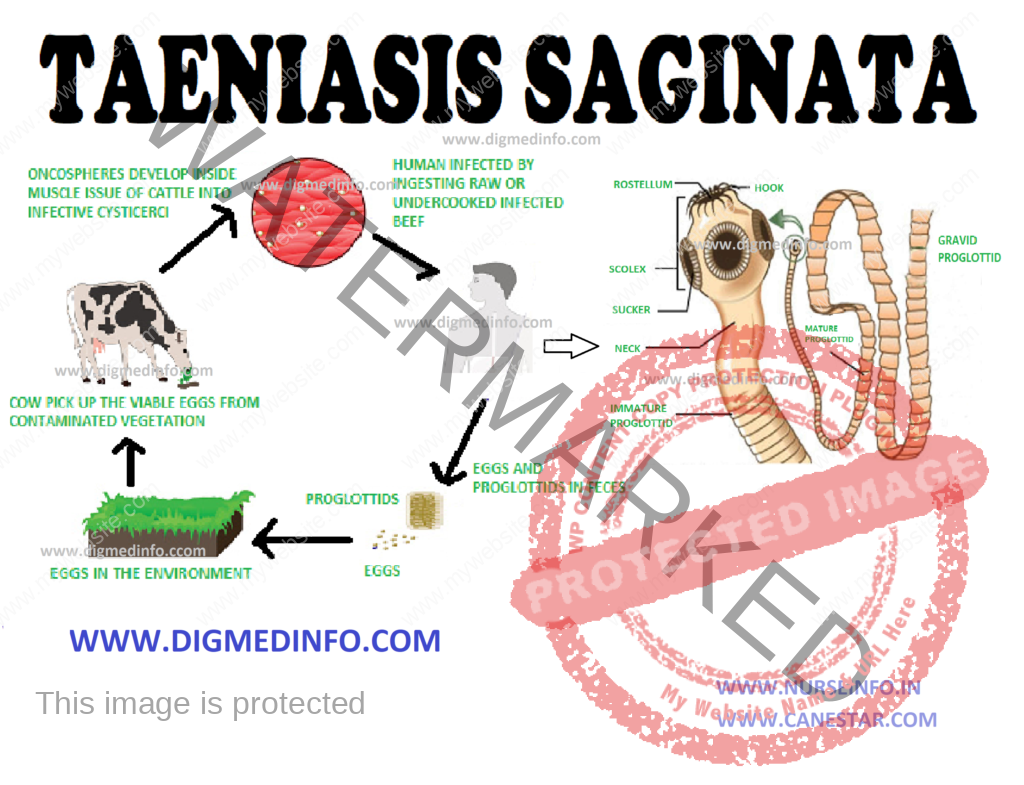UNARMED TAPEWORM (Taeniasis saginata) (Beef Tapeworm) – General Characteristics, Life Cycle, Clinical Features, Diagnosis, Treatment and Prevention
GENERAL CHARACTERISTICS
Taeniasis saginata is infection caused by Taenia saginata. This is the commonest among the large tapeworms found in man and is distributed worldwide. Prevalence is highest in areas where beef is a major source of meat. The adult worm grows to a length of 10 meters and may consist of over 2000 segments. It lies free in the jejunum and ileum, the head being attached to the mucosa. The scolex is 2 mm in diameter and bears no hooklets, but has four suckers. The gravid segments are actively motile and they come out in chains along with feces or wriggle out singly due to their intrinsic muscular action. The uterus has about 20 lateral branches.
The eggs are spherical measuring 30-45 μ in diameter and the egg shell is thick, striated and bile-stained. The embryo or onchosphere bears six hooklets and it remains viable for 4-8 weeks. The adult worm may live for 10-25 years.
Life Cycle
Man is the definitive host and cattle and llamas form the intermediate hosts. Eggs passed in feces contaminate soil. These are ingested by grazing cattle. The onchospheres are liberated in the intestine and they penetrate the mucosa, enter the blood stream, and reach various muscles, mainly those of the heart, tongue, shoulder, neck and loins. On reaching these sites the onchospheres lose their hooks and grow into the cystic stage known as cysticercus bovis in 60-70 days. The cysticercus is ovoid, measures 8 × 5 mm and contains a single sprouting scolex. Cysticercus remains viable for 1-3 years within the muscles. Heavily infected meat is easy to distinguish by the presence of numerous cysts.
On ingesting undercooked meat, the cyst wall is digested and the head attaches itself to the intestinal mucosa and rapidly grows to reach the adult size in 6-8 weeks. A host usually harbors only one or two worms.
Clinical Features
Majority is asymptomatic, though vague symptoms such as abdominal pain, diarrhea and increased appetite may occur in a few. The motile segments emerging out of the anus may cause pruritus and anxiety to the host. Appendicitis and biliary obstruction have been reported rarely.
Diagnosis
History of passing segments and seeing the segments in feces confirm the diagnosis. The species can be identified by observing the number of lateral branches of the uterus. An easy method is to press the segment between two glass slides and to hold it against light. Taenia saginata segment has more than 15 lateral branches, whereas Taenia solium has only less than 13. Eggs can be demonstrated by microscopic examination of the feces or by examining perianal scotch tape swab. The eggs of T. saginata, T. solium and T. echinococcus cannot be differentiated from each other
Treatment
Both niclosamide (Yomesan) and praziquantel are effective against T. saginata. Niclosamide kills the scolex and segments on contact. Four tablets, each of 0.5 g, are given as a single dose to be thoroughly chewed in the morning with a gulp of water. The worm is passed partially digested 24-36 h later. If the whole worm including the scolex is not passed, the worm re-grows and segments reappear in stools within 3 months. In this case the drug is repeated in the same dose. Praziquantel in a dose of 10-15 mg/kg body weight given as a single dose orally is adequate to dislodge the intestinal adult worm in almost all cases. The drug is generally safe. Side effects include dizziness, headache, vomiting and allergy. It is available as tablets of 500 mg and 600 mg.
Prevention
Taenia saginata infection can be prevented by avoiding infected beef, inspection of slaughterhouses and proper disposal of excreta.


